What it’s like on a cycling trip through a part of Europe that few tourists see
Advertisement
Experiences
What it's similar on a cycling trip through a part of Europe that few tourists see
Five friends commence on a 161km-wheel trail that follows an old train track, winding through Bosnia, Herzegovina and Croatia.
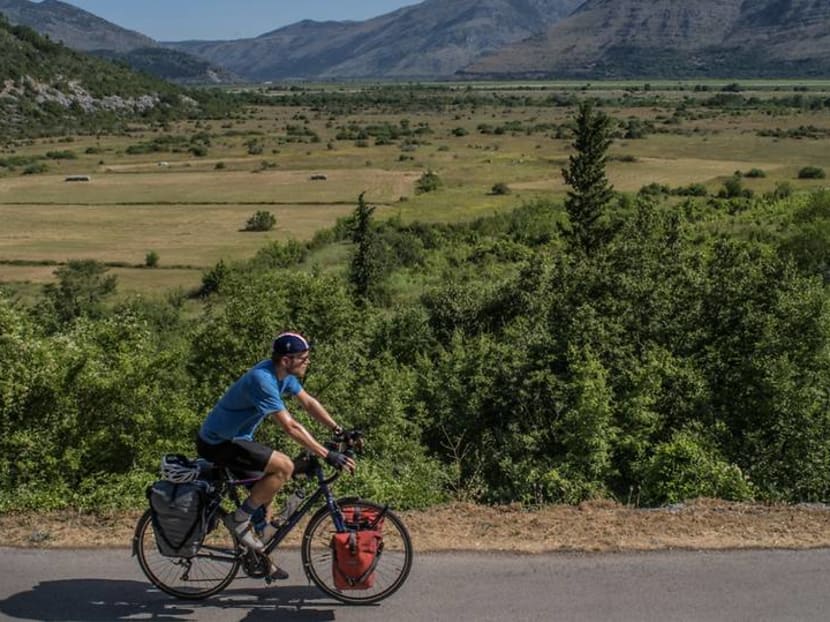
Pedalling through Popova Polje, ane of the largest valleys in Bosnia and function of the Ciro Trail, a wheel path that follows an old railway line from Bosnia to Croatia. (Photo: NYT)
My four friends and I rolled our bikes to a bar one sunny afternoon well-nigh the town of Zitomislici on the banks of the emerald greenish Neretva River in rural Bosnia. We stopped at Neretvansky Gusar, as the bar is called, to restock our water supply. There was just one problem: "I just accept ice-cold beer," apologised the longhaired proprietor, Nikola Bevanda, who prefers the nickname Svabo, slang for 'the German'.
Nosotros looked at one another, and simultaneously dropped our bikes. A few minutes afterward, cans of cold beer in forepart of united states of america on the outdoor picnic tabular array, Svabo appeared, a half-empty bottle of off-make Canadian whiskey in hand, and the impromptu party was officially on. "It's all rock 'n' scroll," he said. "That's my life's motto."
Little did nosotros know at the time that "rock 'due north' roll" would be our motto, as well – only much more literally – for this bike ride. It was the beginning of a iii-day, two-wheeled journey through Bosnia. My four friends and I were pedalling the Ciro Trail, a 2-year-erstwhile bicycle path that follows an old railway line from Mostar in Bosnia and Herzegovina to Dubrovnik in Croatia. When I'd heard the 100-mile (161km) trail is flanked by fields still littered with land mines, past villages abandoned since the Balkan conflict of the early 1990s, and by old railway stations converted to hotels and restaurants, I knew I had to do it.
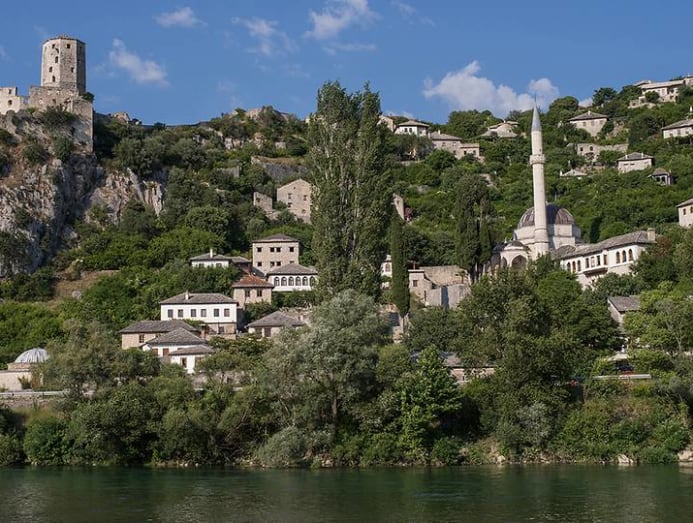
The combination of recent history and Bosnia'due south stunning natural dazzler was appealing. As I told people most the coming trip, some friends were so intrigued they invited themselves forth: Kim Barker, a reporter for The New York Times; Caroline Trefler, a guidebook editor; and the brothers Vedran and Darko Perojevic, owners and chefs of the Dubrovnik eating place Azur. Kim and Caroline arrived fully prepared for the ride with proper equipment. The brothers Perojevic, having lugged fold-up electrical bikes to Mostar for the ride, were decidedly less and then. And I, the organiser of the trip, could have packed more a few T-shirts, a baseball cap and swimming trunks. One aspect that helped, though, is that Kim, Caroline and I rented bikes from the Dubrovnik-based tour operator Epic Croatia, which offers reasonably priced mountain cycle rentals and a transfer (with the bikes) to Mostar and so we could do the trail just one fashion.
Nosotros were cruising through the boondocks of Surmanci when nosotros hit the brakes for an outdoor marketplace. Nosotros were about four miles from Medjugorje, where in 1981 six children claimed to accept had a vision of the Virgin Mary; the town has since been a major pilgrimage finish. Surmanci was shut enough to the holy village to get into the deed of selling pilgrimage souvenirs. Women called to us to part with our money for beaded bracelets, images of the Virgin, and wooden crosses. "Lady!" they yelled repeatedly at our female companions. "Lady!" Kim bought a few knickknacks to give to friends back domicile. And she also acquired the nickname "Lady" for the balance of the trip.
Later on sleeping in the comfy only no-frills Motel Jelcic in the unremarkable town of Capljina that night, we began Day 2 by pedalling by sleepy villages and across rusty iron-lattice train bridges. The path would often gently curve along a mountainside, revealing its former self as a railroad train line.
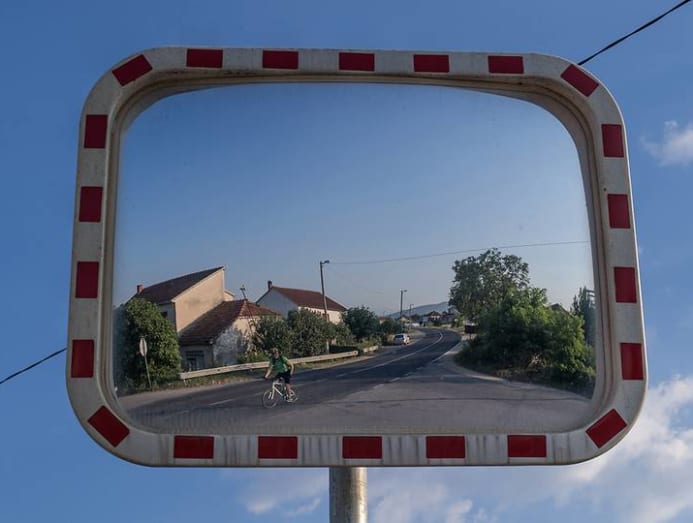
The first train chugged out of Dubrovnik toward Mostar on July fifteen, 1901, with dignitaries seated in carriages equally the train was met past cheering crowds. In 1976, the runway line was deemed no longer financially feasible past the then-ruling Yugoslavian government and shut downward. These days it'south by and large foot-powered vehicles that chug along the trail, thanks to an effort by local bicycling clubs on both sides of the border to do something with this unused stretch of trail, and to aid bring tourists to a part of Europe few outsiders see.
About v miles into the day's ride, we came to a fork. The signposts indicated we could take the easier paved route or ability through the uphill gravel trail that directly follows the old rail line. We opted for the latter and were rewarded with views of Hutovo Blato, a nature reserve that is mostly made upwards of marshland and tall, dark green, pyramid-shape mountains, office of the Dinaric Alps. Pedalling mostly uphill and on lawn tennis-ball-size chunks of white limestone was the 'stone' portion to the previous twenty-four hour period'southward 'curl'. It wasn't easy, merely we stopped frequently to admire the surround.
At one indicate, we encountered 20-pes (6.1m)-tall walls of white limestone. Someone had spray-painted on the stone 'Beware of encarmine vampires' in Bosnian. Vedran translated it, and we all chuckled and shrugged. Only then a few miles after, we got the joke. As we turned a corner, an ominous black passageway awaited united states of america. Vedran and Darko led the way, pushing their bikes into the erstwhile railroad train tunnel before completely disappearing into the blackness.
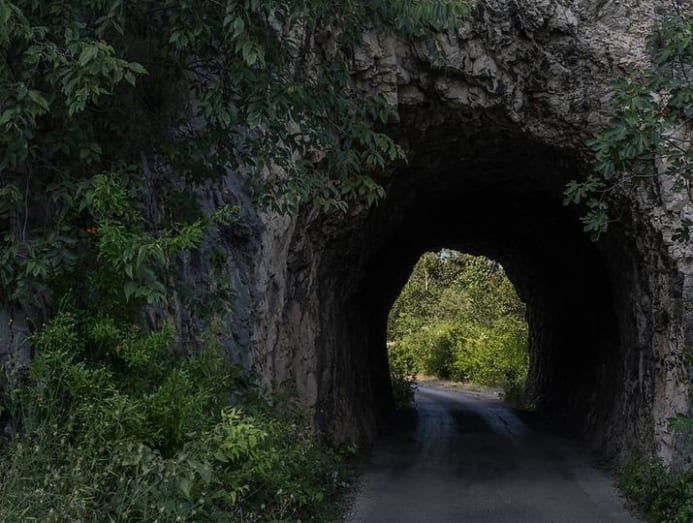
About halfway through the 400-foot tunnel, still completely black save for Caroline'south flashlight, we began hearing a cacophony of high-pitched, squeaky, chirping noises. And information technology wasn't our bicycles. We all paused. I could feel my heartbeat speeding up. What kind of ground forces of creatures was awaiting u.s.?
Caroline pointed her flashlight up to the ceiling and nosotros all screamed at the sight: Hundreds of bats swirling just over our heads. Nosotros had roused them from their sleep, and they didn't seem happy. Vedran was trying to play it cool, as we pushed our bikes faster through soft bat guano. My tire inadvertently rubbed against his dogie, and he let out a loud, panicked scream. We all laughed, which lightened the mood. Afterward we pushed through the tunnel, we took a breather, relieved that none of us had been converted to vampires. Or so nosotros hoped. Back on the bikes, nosotros crossed the iron Stangerova Cuprija bridge.
A couple of hours later, we cruised into Ravno and checked in to our hotel, Stanica Ravno, a former railway station that opened as a hotel last year. The first thing we did, naturally, was go to the outdoor restaurant and social club a round of beers.
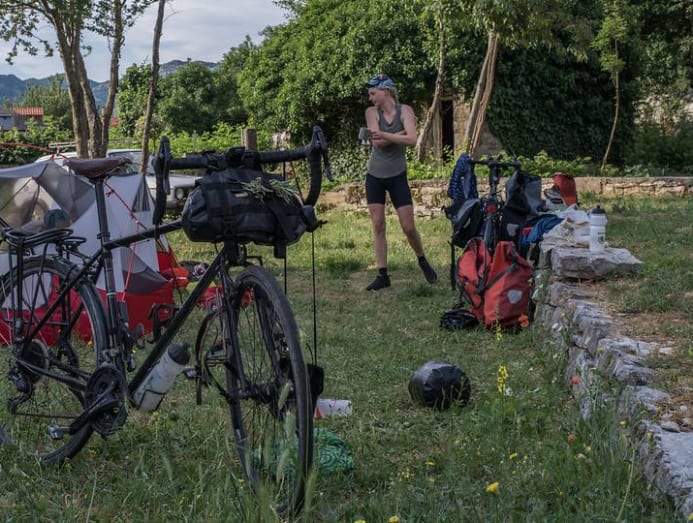
That nighttime, our last in Bosnia before crossing the border, we feasted on grilled meat and sipped local vino at the hotel restaurant, happy our adventure with the bats was over. The next twenty-four hour period we began by having java at Gostinica Zavala, a former train station that is now a restaurant. Within was a photo of the day the Ciro Train offset pulled through the hamlet of Zavala in 1901. The railway was flanked by hundreds of people cheering every bit the train chugged past. We cheered that the path in forepart of united states was mostly paved and relatively flat.
Darko would occasionally stop to choice things off copse and plants on the side of the trail – sour cherries, hibiscus, mulberries, oregano – and offer it to us. A perk of travelling with a chef. Nosotros followed the long, gentle curve that stretched forth the side of Popova Polje, ane of the largest valleys in Bosnia. Here the road signs began to change from the Latin alphabet to the Cyrillic. We were now inbound Republika Srpska, a quasi-autonomous strip of Bosnian-Serb country that was the result of a compromise that ended the Bosnian State of war at the Dayton Accords in 1995.
Just afterward passing through the hamlet of Hum, a haunting hodgepodge of grazing cows and abandoned 19th-century buildings, many in a land of busted (and where apparently about x people still reside), nosotros began seeing ominous signs on the side of the trail brandished with a skull and crossbones and the word MINE in Cyrillic. So we came upon a group of guys, some wearing what looked like impenetrable jackets, standing effectually smoking and chatting. They were part of a Bosnian team from Norwegian People'southward Help, an NGO that locates and defuses land mines.
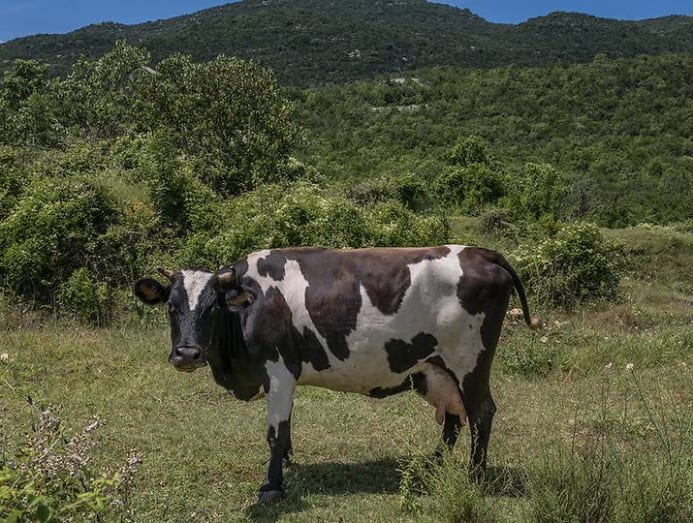
The group's leader, Nerven Stonic, said, "We're trying to rid this area of land mines with the hope to open up it up to tourism – making it better for people like y'all to ride through." That's when Vedran asked if they had whatever water. "If nosotros did," Stonic said, "we'd certainly offer information technology to you." Vedran made an offering of his own: "How near an water ice-cold beer?" Stonic laughed and said, "That would be smashing, but in our line of work, it would be seriously questionable if nosotros drank booze on the job."
The guys picked upwards their metal detectors and went back to work, and we picked up our bikes and pedalled the last five or then miles before reaching the Bosnian-Croation border. In the now-abandoned town of Uskopje, we went past the railway station, now populated by cows. They watched us bike by, seemingly unfazed, and then, in the town of Ivanica, we reached the edge, experiencing that odd feeling of existence on a bicycle sandwiched past revving automobiles.
After a quick stamp of our passports, we coasted downwardly a steep, paved path that delivered united states right into Gruz Harbor in Dubrovnik. We sailed by the one-time railway station where the Ciro Train first made its inaugural journey and right into the bar at a new arts and crafts brewery, the Dubrovnik Beer Company, where we had i concluding celebratory water ice-cold beer. "It's all rock 'n' roll," we said, and clinked our pint spectacles.

Recent Searches
Trending Topics
Source: https://cnalifestyle.channelnewsasia.com/experiences/cycling-in-eastern-europe-246196

0 Response to "What it’s like on a cycling trip through a part of Europe that few tourists see"
Post a Comment